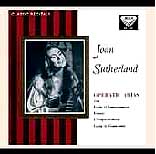I doubt if there’s ever been a more astonishing debut recital in the history of the LP. Sutherland sang the “Lucia” heard ’round the world in February of 1959 at Covent Garden and became an overnight sensation; Decca wisely leaped in, and this recital was recorded at the end of April. Every word is clearly articulated and emphasized, every consonant heard; within two or three years roundness of tone had taken precedence over textual clarity. But this recital has both. What possible explanation can there be for the drastic difference? For many years there was speculation that it was some sort of dental catastrophe that caused Sutherland’s diction to go mushy; if that’s so, it’s time to sue the dentist.
At any rate, it’s the singing that matters, and even today it startles. Had a large voice ever had such agility, perfect control, spotless runs, and ease up to a brilliant high E-natural (interpolated at the close of the Bolero from Verdi’s I vespri Siciliani, which also requires the soprano to clearly enunciate a low-C more than two octaves below), not to mention a trill that simply defines the term? Lucia’s fountain scene as sung here is girlish and filled with both wonderment and trembling, and the cadenza is as virtuosic as one could hope for. And the Mad Scene simply has to be heard to be believed. We may get little of Callas’ depth, but Sutherland does marvelous things with “Alfin son tua”, expressing Lucia’s true sadness. Then comes the cadenza with flute, and you simply can’t believe your ears–to this day I suspect it has not been sung as well. “Ernani involami” hasn’t sounded so good since Ponselle, and I dare say the passage-work is more fluent–and again, those trills are spine chilling. Linda’s adorable “O luce di quest’anima” is all lightness and air, with impeccable staccatos and the true feel of a young girl. If you don’t own this recital, your collection is incomplete. [11/16/2004]
































